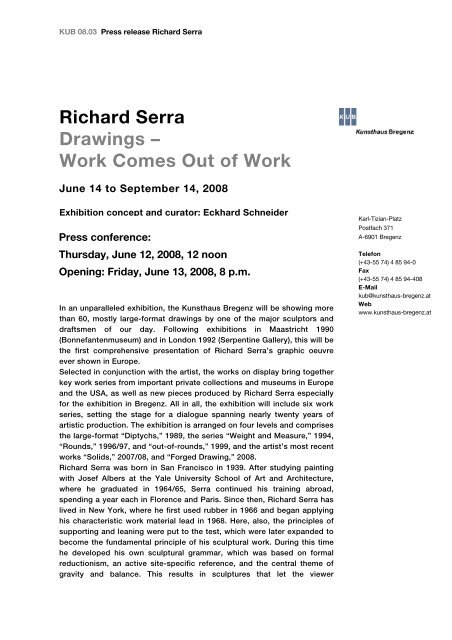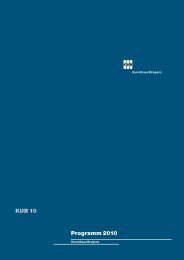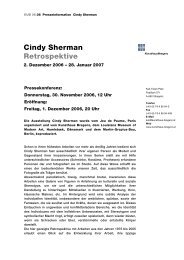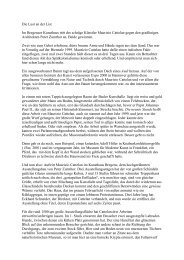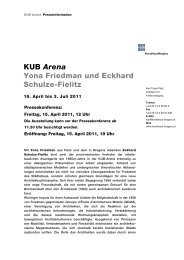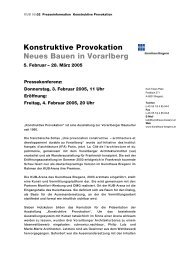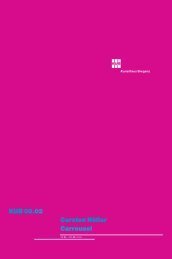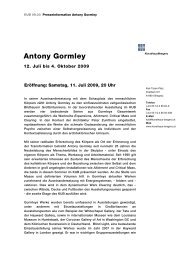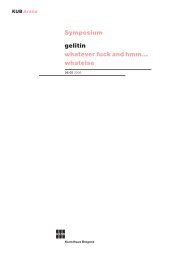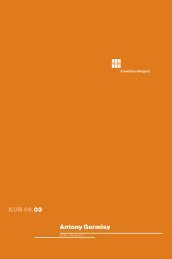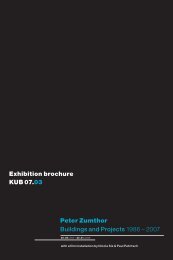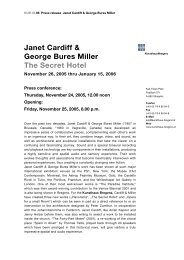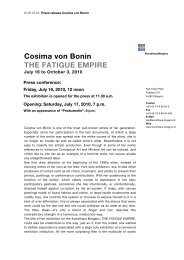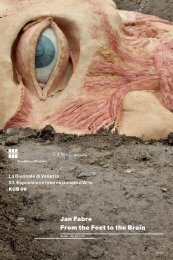Richard Serra Drawings – Work Comes Out of Work
Richard Serra Drawings – Work Comes Out of Work
Richard Serra Drawings – Work Comes Out of Work
Create successful ePaper yourself
Turn your PDF publications into a flip-book with our unique Google optimized e-Paper software.
KUB 08.03 Press release <strong>Richard</strong> <strong>Serra</strong><br />
<strong>Richard</strong> <strong>Serra</strong><br />
<strong>Drawings</strong> <strong>–</strong><br />
<strong>Work</strong> <strong>Comes</strong> <strong>Out</strong> <strong>of</strong> <strong>Work</strong><br />
June 14 to September 14, 2008<br />
Exhibition concept and curator: Eckhard Schneider<br />
Press conference:<br />
Thursday, June 12, 2008, 12 noon<br />
Opening: Friday, June 13, 2008, 8 p.m.<br />
In an unparalleled exhibition, the Kunsthaus Bregenz will be showing more<br />
than 60, mostly large-format drawings by one <strong>of</strong> the major sculptors and<br />
draftsmen <strong>of</strong> our day. Following exhibitions in Maastricht 1990<br />
(Bonnefantenmuseum) and in London 1992 (Serpentine Gallery), this will be<br />
the first comprehensive presentation <strong>of</strong> <strong>Richard</strong> <strong>Serra</strong>’s graphic oeuvre<br />
ever shown in Europe.<br />
Selected in conjunction with the artist, the works on display bring together<br />
key work series from important private collections and museums in Europe<br />
and the USA, as well as new pieces produced by <strong>Richard</strong> <strong>Serra</strong> especially<br />
for the exhibition in Bregenz. All in all, the exhibition will include six work<br />
series, setting the stage for a dialogue spanning nearly twenty years <strong>of</strong><br />
artistic production. The exhibition is arranged on four levels and comprises<br />
the large-format “Diptychs,” 1989, the series “Weight and Measure,” 1994,<br />
“Rounds,” 1996/97, and “out-<strong>of</strong>-rounds,” 1999, and the artist’s most recent<br />
works “Solids,” 2007/08, and “Forged Drawing,” 2008.<br />
<strong>Richard</strong> <strong>Serra</strong> was born in San Francisco in 1939. After studying painting<br />
with Josef Albers at the Yale University School <strong>of</strong> Art and Architecture,<br />
where he graduated in 1964/65, <strong>Serra</strong> continued his training abroad,<br />
spending a year each in Florence and Paris. Since then, <strong>Richard</strong> <strong>Serra</strong> has<br />
lived in New York, where he first used rubber in 1966 and began applying<br />
his characteristic work material lead in 1968. Here, also, the principles <strong>of</strong><br />
supporting and leaning were put to the test, which were later expanded to<br />
become the fundamental principle <strong>of</strong> his sculptural work. During this time<br />
he developed his own sculptural grammar, which was based on formal<br />
reductionism, an active site-specific reference, and the central theme <strong>of</strong><br />
gravity and balance. This results in sculptures that let the viewer<br />
Karl-Tizian-Platz<br />
Postfach 371<br />
A-6901 Bregenz<br />
Telefon<br />
(+43-55 74) 4 85 94-0<br />
Fax<br />
(+43-55 74) 4 85 94-408<br />
E-Mail<br />
kub@kunsthaus-bregenz.at<br />
Web<br />
www.kunsthaus-bregenz.at
2/2<br />
KUB 08.03 Press release <strong>Richard</strong> <strong>Serra</strong><br />
experience the critical balance <strong>of</strong> different forces and whose large-scale<br />
dimensions impart a strong physical and emotional experience.<br />
<strong>Serra</strong>’s first solo exhibition in 1969 at the Leo Castelli Gallery in New York<br />
was followed by many large international presentations <strong>of</strong> his sculptural<br />
work, landscape projects, and site-specific installations using his primary<br />
material: steel. After his large-scale retrospective at the Museum <strong>of</strong><br />
Modern Art in 2007, <strong>Richard</strong> <strong>Serra</strong> is currently showing “Promenade,” the<br />
monumental sculpture he created for the Grand Palais in Paris.<br />
Since 1971, <strong>Serra</strong> has focused not only on sculptural works, but also on<br />
large-scale drawings using various techniques. These are as important to<br />
him as his sculptures, and as the artist himself explains: “I like to draw. It<br />
is an activity I rely on, a dependency <strong>of</strong> sorts. Drawing gives me an<br />
immediate return for my effort and the result is commensurate with my<br />
involvement. It is an activity that requires solitude, it is the most<br />
concentrated space in which I work.”<br />
In another context, he calls drawing the source <strong>of</strong> his artistic activity, not<br />
least because it affords him the freedom to think about the elementary<br />
conditions <strong>of</strong> his sculptural pieces without needing to rework them. <strong>Serra</strong><br />
has always drawn. He was accepted to the Yale School <strong>of</strong> Art based on the<br />
drawings he submitted. The color he uses in his drawings is black. A dense<br />
layer <strong>of</strong> paintstick absorbs and dissipates light; what emerges is the mass,<br />
density, and volume <strong>of</strong> the drawing. “Black is a property, not a quality. In<br />
terms <strong>of</strong> weight, black is heavier, creates a larger volume, holds itself in a<br />
more compressed field. It is comparable to forging. […] To use black is the<br />
clearest way <strong>of</strong> marking against a white field.” (<strong>Richard</strong> <strong>Serra</strong>) In other<br />
words, the artist finds it is also the clearest way <strong>of</strong> indicating something<br />
without triggering associations because black is interpreted as a material<br />
substance rather than a color. Unlike the site-specific “Wall <strong>Drawings</strong>,”<br />
which, rendered directly onto cloth, operate with the proportions and<br />
scales <strong>of</strong> the existing architecture, <strong>Serra</strong>’s drawings on paper are not<br />
bound by context. The frame serves, instead, to separate the paper<br />
drawing from the wall.<br />
<strong>Richard</strong> <strong>Serra</strong>’s drawing material is the paintstick, a wax-like grease<br />
crayon. <strong>Serra</strong> melts several paintsticks to form large pigment blocks. This<br />
transformation allows him to apply the black material in broad, dense<br />
strokes. Warming or melting the material for his drawings, he applies it<br />
either directly onto the paper with large sweeps <strong>of</strong> his arm, or he uses a<br />
window-screen as an intermediary surface through which he presses the<br />
color. In his recent “Solids,” <strong>Richard</strong> <strong>Serra</strong> goes a step further. “Melted<br />
paintstick is poured onto a hard surface on the floor. Sometimes, not<br />
always, a sheet <strong>of</strong> window-screen is placed on top <strong>of</strong> the liquid paintstick.
3/3<br />
KUB 08.03 Press release <strong>Richard</strong> <strong>Serra</strong><br />
Then the paper is laid down, either on top <strong>of</strong> the screen or directly on top<br />
<strong>of</strong> the liquid paintstick. Pressure is exerted on the back <strong>of</strong> the paper with a<br />
hard marking tool. The front side <strong>of</strong> the paper picks up the mark. With a<br />
few exceptions where the front is marked through a blackened screen, no<br />
direct drawing is done on the front <strong>of</strong> the paper. I don’t see the drawing I<br />
am making until the paper is pulled <strong>of</strong>f the floor and turned over or the<br />
screen is lifted.”<br />
The material and the entire work process serve to build the drawing step<br />
by step. It is an elementary process, which, carried out with intense<br />
energy, is the result <strong>of</strong> direct action. By splitting and discontinuing the<br />
flow, <strong>Richard</strong> <strong>Serra</strong> avoids the gestural and allows a dense superficial<br />
construction. <strong>Serra</strong> avoids gestural features in order to sharpen the<br />
awareness <strong>of</strong> the viewer and draw attention to one’s own corporeality. He<br />
is not concerned with subjective gestures or narrative references; at the<br />
core <strong>of</strong> his drawings is the principle <strong>of</strong> marking, <strong>of</strong> the anonymous<br />
characteristic style in which the drawing seems to find its form through the<br />
density <strong>of</strong> the material and the compact work process. Precisely because<br />
every illusory strategy is avoided, the forms are at the same time able to<br />
imply weight, mass, and volume. For, particularly through his training with<br />
Josef Albers, <strong>Richard</strong> <strong>Serra</strong> is fully aware that the weight <strong>of</strong> a drawing<br />
does not just depend on the layers <strong>of</strong> paintstick applied, but above all on<br />
its form.<br />
For the works <strong>of</strong> the series “Weight and Measure,” <strong>Richard</strong> <strong>Serra</strong> has<br />
brought together two large sheets <strong>of</strong> double-laminated Hiromi paper. He<br />
treats each <strong>of</strong> the two as an active substance rather than a passive ground<br />
by positioning the upper sheet so that it only very slightly overlaps with the<br />
lower one. Together with the black areas applied as layers <strong>of</strong> paintstick,<br />
these drawings, like the “Diptychs,” are reminiscent in their work process<br />
<strong>of</strong> the balancing <strong>of</strong> steel slabs with space, weight, equilibrium, size, scale,<br />
placing, and density.<br />
The series “Rounds” and “out-<strong>of</strong>-rounds” result from the application <strong>of</strong><br />
material in an exhausting process, which, by virtue <strong>of</strong> the thick layers <strong>of</strong><br />
paintstick, gives the forms material presence, mass, and weight. In this<br />
way, in “out-<strong>of</strong>-rounds” a curved cardboard shape marks the<br />
circumference and defines the paintstick borders during application.<br />
Liquid material under pressure shoots out and produces the explosive<br />
markings at the edges.<br />
With his “Forged Drawing,” which was created especially for Bregenz,<br />
<strong>Serra</strong> picks up on a work series from the seventies and eighties. It deals<br />
with steel masses in each <strong>of</strong> the four basic shapes that can be forged with<br />
a blacksmith’s hammer: circle, rectangle, octagon, and square. “These are
4/4<br />
KUB 08.03 Press release <strong>Richard</strong> <strong>Serra</strong><br />
the building blocks which most forged products can be traced back to. I<br />
thought it would be worth the effort to point out that the circle, rectangle,<br />
octagon, and square are the graphic elements from which everything a<br />
blacksmith forges derives. I interpreted this literally and re-presented this<br />
idea by hanging the steel forms on the wall and covering their surfaces<br />
with a paintstick.”<br />
<strong>Serra</strong>’s programmatic drawing concept <strong>of</strong> connecting body awareness with<br />
material and integrating both visual and tactile perception allows the<br />
viewer to experience a densified, intensified space in connection with<br />
densified, materialized time.
5/5<br />
KUB 08.03 Press release <strong>Richard</strong> <strong>Serra</strong><br />
KUB-Publications<br />
<strong>Richard</strong> <strong>Serra</strong><br />
<strong>Drawings</strong> <strong>–</strong> <strong>Work</strong> <strong>Comes</strong> <strong>Out</strong> <strong>of</strong> <strong>Work</strong><br />
For the first time since 1990, the Kunsthaus Bregenz will be showing<br />
approximately 60 drawings by <strong>Richard</strong> <strong>Serra</strong> in a comprehensive<br />
presentation <strong>of</strong> the sculptor’s graphic oeuvre.<br />
The catalogue being published in conjunction with this historically important<br />
exhibition is being produced in close cooperation with <strong>Richard</strong> <strong>Serra</strong> and will<br />
present six work series from nearly two decades <strong>of</strong> his artistic practice. As a<br />
special highlight the large format “Diptychs” (1989) will be juxtaposed against<br />
the artist’s most recent work series “Solids” (2007/08). The work “Forged<br />
Drawing,” recently reworked especially for the Kunsthaus Bregenz, as well as<br />
the work series “Weight and Measure,” “Rounds,” and “out-<strong>of</strong>-rounds” all<br />
combine to convey the independent power and artistic significance <strong>of</strong><br />
<strong>Richard</strong> <strong>Serra</strong>’s graphic work. The catalogue will contain high-quality, largeformat<br />
reproductions <strong>of</strong> all the drawings in this exhibition, in part as foldouts.<br />
James Lawrence and <strong>Richard</strong> Shiff, two art historians and <strong>Serra</strong> specialists,<br />
will contribute knowledgeable essays on <strong>Serra</strong>’s graphic work, which is<br />
certainly on a par with his sculptures.<br />
A selected biography and a bibliography based on the work series shown in<br />
this exhibition will round <strong>of</strong>f this bilingual volume, making it a standard work<br />
on the artist.<br />
<strong>Richard</strong> <strong>Serra</strong><br />
<strong>Drawings</strong> <strong>–</strong> <strong>Work</strong> <strong>Comes</strong> <strong>Out</strong> <strong>of</strong> <strong>Work</strong><br />
German/English<br />
Ed. by Eckhard Schneider, Kunsthaus Bregenz<br />
Design: Peter Dorén, Dorén+Köster, Berlin<br />
With essays by James Lawrence and <strong>Richard</strong> Shiff<br />
228 pages, 24 x 30 cm<br />
Hardcover, cloth, with dust jacket<br />
Publication date: in time for the opening <strong>of</strong> the exhibition on June 13, 2008<br />
Price: € 58
6/6<br />
KUB 08.03 Press release <strong>Richard</strong> <strong>Serra</strong><br />
KUB-Editions<br />
<strong>Richard</strong> <strong>Serra</strong><br />
out-<strong>of</strong>-round X<br />
Close cooperation with the artists while planning the exhibition results in<br />
special editions designed exclusively for the Kunsthaus Bregenz.<br />
This work is originally from the work series “out-<strong>of</strong>-rounds,” 1999, and was<br />
selected by <strong>Richard</strong> <strong>Serra</strong> as a poster motif and as the special print for this<br />
edition. The unique printing process used conveys the dense materiality <strong>of</strong><br />
the black paintstick, which forms the basis <strong>of</strong> the original drawing.<br />
<strong>Richard</strong> <strong>Serra</strong><br />
out-<strong>of</strong>-round X, 1999/2008<br />
Novaton printing (duo-tone with paint) on heavy Tintoretto-Gesso paper<br />
Size <strong>of</strong> paper: 69,4 x 59,4 cm<br />
Limited edition <strong>of</strong> 251 pieces, numbered and signed<br />
Subscription price during the exhibition: 200 €<br />
Price after the exhibition: 250 €, price incl. 10% VAT,<br />
plus postage and packaging<br />
Contact: Caroline Schneider<br />
c.schneider@kunsthaus-bregenz.at<br />
Tel.: (+43) 55 74 / 4 85 94-444
7/7<br />
KUB 08.03 Press release <strong>Richard</strong> <strong>Serra</strong><br />
KUB-Billboards<br />
Jitka Hanzlová<br />
Forest, 2000-2005<br />
June 1 - September 14, 2008<br />
Seestraße Bregenz<br />
Opening and slide show presentation by the artist :<br />
Sunday, June 15, 2008, 2.00 p.m.<br />
Kunsthaus Bregenz, lecture hall, first basement<br />
Jitka Hanzlová, born in Náchod/Czech Republic in 1958, lives and works as<br />
an independent artistic photographer in Germany. For her project “Forest,”<br />
the artist returned to the place where she grew up and spent several years<br />
exploring the forest with her camera. During this time she kept notes on her<br />
thoughts and reflections.<br />
Here a few excerpts from her “Forest Diary”:<br />
In the forest there was nobody looking at me, communicating with me<br />
directly, so I had to look more and more − into myself.
8/8<br />
KUB 08.03 Press release <strong>Richard</strong> <strong>Serra</strong><br />
Partners and Sponsors<br />
The Kunsthaus Bregenz would like to thank its partners for their generous<br />
financial support and the cultural commitment that goes along with it.<br />
Presenting<br />
sponsor<br />
Main sponsor<br />
<strong>of</strong> the Kunsthaus Bregenz<br />
Cultural bodies<br />
Hypo Landesbank<br />
Vorarlberg<br />
Sponsor <strong>of</strong> the<br />
KUB Arena<br />
Kulturhäuser Betriebsgesellschaft<br />
mbH<br />
Media partners Cooperation partners<br />
With kind support from<br />
Gesellschaft der<br />
Freunde des<br />
Kunsthaus Bregenz
9/9<br />
KUB 08.03 Press release <strong>Richard</strong> <strong>Serra</strong><br />
Kunsthaus Bregenz<br />
Venue/Organizer:<br />
Kunsthaus Bregenz<br />
Karl Tizian Platz<br />
A-6900 Bregenz<br />
Exhibition concept:<br />
<strong>Richard</strong> <strong>Serra</strong>,<br />
Eckhard Schneider<br />
Director:<br />
Eckhard Schneider<br />
Curator:<br />
Rudolf Sagmeister<br />
Press and public relations:<br />
Birgit Albers<br />
Phone: (+43-55 74) 4 85 94-413<br />
Fax: (+43-55 74) 4 85 94-408<br />
b.albers@kunsthaus-bregenz.at<br />
Press photos to download:<br />
www.kunsthaus-bregenz.at<br />
Art Education:<br />
Winfried Nußbaummüller<br />
Phone: (+43-55 74) 4 85 94-417<br />
Fax: (+43-55 74) 4 85 94-408<br />
w.nussbaummueller@kunsthausbregenz.at<br />
Publications:<br />
Katrin Wiethege<br />
Phone: (+43-55 74) 4 85 94-416<br />
Fax: (+43-55 74) 4 85 94-408<br />
k.wiethege@kunsthaus-bregenz.at<br />
Editions:<br />
Caroline Schneider<br />
Phone: (+43-55 74) 4 85 94-444<br />
Fax: (+43-55 74) 4 85 94-408<br />
c.schneider@kunsthaus-bregenz.at<br />
Opening hours:<br />
Daily 10 a.m. <strong>–</strong> 8 p.m.


